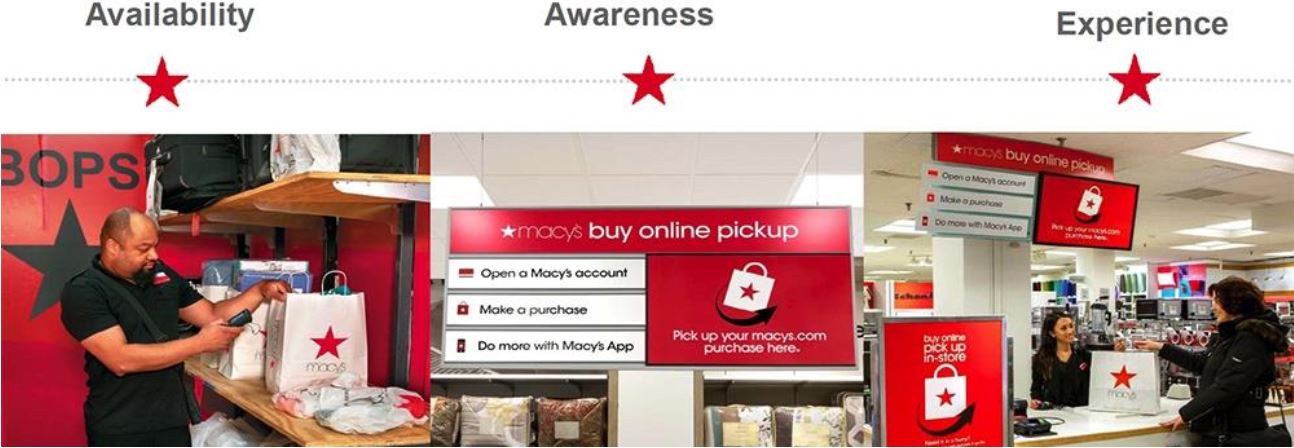Investor Meeting Key Points
Fung Global Retail & Technology attended the Macy’s2017 Investor Meeting in New York on June 6. Presenting from the company were:
Jeff Gennette, President & CEO
Rich Lennox, Chief Marketing Officer
Karen Hoguet, CFO
Doug Sesler, EVP, Real Estate
Management kicked off the meeting by discussing the widely understood challenges the retail industry is currently facing and how Macy’s is going to be a “winner” coming out of this period of change in terms of retail dynamics. E-commerce has lowered the barriers to entry and allowed for increased competition, management noted,and retailers are also dealing with changing consumer shopping patterns and disruption from technology.
The company will need to think more creatively, approach the customer differently and move more quickly. In all, the company sees an opportunity to close the gap between consumers’ connection to and feeling about the Macy’s brand and their shopping habits at Macy’s.
Looking at 2017 more specifically, the company is focusing on continuing to grow its mobile and digital businesses in the double-digit range, stabilizing its brick-and-mortar business and setting up a foundation for future growth.
The North Star Strategy
Management outlined its North Star strategy, which comprises five points that will allow Macy’s to emerge a winner and drive future growth. The five points of the North Star strategy are:
- From familiar to favorite: reengineer the Macy’s marketing machine
- It must be Macy’s: products and experience that can only be found at Macy’s
- Every experience matters: seamless omnichannel experience
- Funding our future: create value
- What’s new, what’s next: think differently on how to find future growth
Management noted that:
- 9% of customers visit Macy’s 18 times per year and spend $2,010 per year, accounting for 86% of the company’s sales.
- 13% of customers visit stores nine times per year and spend $574 per year,accounting for 19% of sales.
- 38% of customers visit stores three times per year and spend $246 per year, accounting for 23% of sales.
The company’s goal is to migrate customers from the second and third tiers to higher tiers by getting to know them using data and analytics and giving them what they want how they want it.
Knowing customers requires knowing their behaviors (spend, frequency and profitability), attitudes (personality traits, values, interests and lifestyle), engagements (engagement with the brand) and demographics (age, gender, income and geography).
The existing customer base has begun to age and Macy’s has lost ground with millennials. Also, the company’s value message has become unclear due to frequent and complicated promotions. The North Star strategy is designed to address these and other challenges.
From Familiar to Favorite: Marketing
There is a disconnect between consumers’ perception of the Macy’s brand and their propensity to shop at Macy’s. According to the company, 50% of Americans shop at Macy’s at least once a year and there are 1.5 billion visits to Macys.com each year. More than 600 million transactions are made at Macy’s in-store and online every year. While these metrics are impressive, the disconnect could be due in part to the current in-store experience, and management talked about how the company is going to address this.

Source: Investors.macysinc.com
On the marketing side, efforts are focused on building a narrative to close the gap between the Macy’s brand and sales in Macy’s stores and online.The company showed several videos of a new marketing campaign that is dramatically different from the current messaging. It seems to be targeted at younger customers. The old campaign did not have a strong enough call-to-action to get customers into stores. The new campaign will work to address that with by making a clearer distinction between events and holidays. The five big changes in the North Star strategy start with revitalizing brand engagement by building tentpole campaigns around the four key seasons and establishing Macy’s as an authority. On the value side, there will be promotional events that are distinct, and a loyalty program will be added as opposed to a rewards program.
The loyalty program is expected to launch in the fourth quarter, and to be first rolled out to the company’s best customers, those who have a Macy’s brand credit card, and then expanded further in 2018. It will be a simple program with clear value and incentives that motivate changes in behavior.There will be tiered benefits that reward the loyalty of the company’s best customers.
In the third quarter, the company will launch The Edit, a program with four pillars:
- Newness (the ability to highlight new and compelling products)
- Just for Macy’s (private brands and exclusives)
- The “it” list (a curated list of top fashions)
- Market leadership (best-in-class partnerships with brands)
It Must Be Macy’s: Product that Can Only Be Found at Macy’s
Challenges with product assortments and the in-store experience have weighed on the company’s performance. Jeff Gennette, the company’s new CEO, talked about “edited, elevated and exclusive assortments,” which translates to a focus on core brands and products, an elevated taste level (with curated fashion to match), and Macy’s being the only destination for private label and exclusive product.
The first aspect of an edited and elevated assortment is having a consistent offering both in stores (in
all stores) and online. That congruent inventory must be complemented by consistent last-mile delivery and buy online, pick up in store service. Elevated fashion is also a component, along with a new merchandise vision filtered by lifestyle and budget. SKU rationalization continues to be a work in progress,although it seems to be in the early stages, as management declined to provide any details or targets. Management did say that it is something it continues to test, noting that one store’s inventory had been reduced by 40%.
Exclusive product comprises private brands, big brands and capsules. The goal is for exclusives to represent 40% of sales by 2020, up from 29% currently. On the private brand side, the company is taking time and cost out of the supply chain by taking less time for decision making and reducing the supplier base by 40%.
The company provided an example of the changes made with the INC private label women’s brand. Management said that the assortment was edited for duplicative items, trends and fashion were elevated, the brand partnered with designers such as Anna Sui for exclusive capsule collections, pricing complexity was reduced, and a supply chain team was embedded to speed up cycle time. The results were positive, including a 10% increase in average unit retail and a one-to-two-point increase in sell-through.
Some of the assortment metrics highlighted included the above mentioned goal of growing private brands and exclusives to 40% of sales by 2020, increasing inventory turns, improving weekly regular-price sell-through and increasing target average unit retail.
A simplified pricing structure will make it easier for consumers to shop at Macy’s.The company plans to offer a more clear value message coupled with coupons, clearance (Last Act) and Backstage in stores. Management reiterated several times that Macy’s will remain a promotional department store—that is not going to change. The goal is to make pricing less complex and clearer.
Backstage is the Macy’s off-price concept, which the company has been and continues to roll out in existing Macy’s full-line stores. These concepts are typically 15,000–25,000 square feet in size. The company decided to launch Backstage after learning that about two-thirds of its best customers also shopped off-price and because it had excess space to fill, specifically in stores that were less productive than the chain overall. The company continues to test and iterate to improve Backstage performance. Net sales in stores with a Backstage have seen an incremental lift of 4.6–6.4 points, depending on when the Backstage store was opened.Stores opened in 2017 are performing better than those opened in 2016. The best-performing categories at Backstage are those that have a significant delta in price relative to the categories in the full-line stores. For example, management said that the beauty category—particularly bath and body products—had seen particular success. Home décor and home organization were also noted as performing well, and these categories are not available in Macy’s stores.
Management said that 26% of Backstage customers also shop at the main store on the same trip. The company plans to open Backstage stores in more than 40 Macy’s stores in 2017 and will scale the best solutions to base stores in 2018.
Every Experience Matters: Digital and Mobile
Macy’s has leading digital and mobile platforms and has had a mobile-first focus since 2014. The company’s omnichannel customers are highly engaged and are significantly more valuable than either online-only or in-store-only customers. The company’s expansion of its digital capabilities complements its brick-and-mortar portfolio.
Buy online, pick up in store has proven a successful combination of e-commerce and brick-and-mortar for Macy’s, and such transactions are the company’s most profitable. The service improves margins by cutting out shipping costs and increases sales, as many customers shop more when they get to the store to pick up their online orders. Customers love the option because they get access to items quickly and avoid shipping fees. There are three important aspects to growing buy online, pick up in store:
- Availability: How do you get the base congruent inventory in every store?
- Awareness:How do customers know or learn about the option?
- Experience:How is it convenient and easy for the customer?

Source: Investors.macysinc.com
In terms of availability, the hardest of the three challenges to conquer, most of the heavy lifting has already been done. Signage in stores and on the website has been added to promote the buy online, pick up in store service, and pickup locations have been moved to right near the front door or main entrance of stores to make it easy and convenient for customers (these areas were previously located at the back of stores).
Funding Our Future: Value Creation
Macy’s has removed $1.5 billion in costs since 2015, while reinvesting $500 million in growth strategies. The company continues to focus on taking costs out of the business and operating more effectively and efficiently.
In the near term, the goal is to stabilize performance in 2017 in order to achieve better results in 2018 and 2019. The company maintained its 2017 guidance for comps of (3)%–(2)% on an owned-plus-licensed basis. The comp guidance assumes an incremental $250 million in sales based on an annualized run rate of May trends of (3)% at the low end. The high end of guidance assumes incremental revenue. The company estimates incremental revenue of $200–$260 million in the second through fourth quarters of this year. Broken down, the company expects to generate $100–$125 million from merchant initiatives, specifically in shoes, fine jewelry and big ticket items; $75–$100 million from retention from closed stores (when a store closes and there is another store in the same market, a portion of sales are retained); and $25–$35 million from the rollout of additional Backstage stores.

Source: Investors.macysinc.com
The company maintained its adjusted EPS guidance of $3.37–$3.62 for the year. CFO Karen Hoguet noted that there could be risks to the gross margin rate, but that these should be offset by additional expense reduction opportunities (excluding asset gains) and asset sales.
The company’s real estate strategy is also leading to significant cash flow. Macy’s saw proceeds of $673 million from asset sales in 2016 and $204 million in 2015.
In the short term, excess cash will be used to fund the business, maintain the dividend and reduce debt. The company expects to return to share buybacks once it reaches its leverage target.
What’s New, What’s Next: Thinking Differently for Future Growth

An improved store experience in the future will encompass an edited, elevated, exclusive product; an open-sell format; Backstage; mobile and tech service improvements;buy online, pickup in store; and loyalty benefits for the company’s best customers. Management said that it has identified 20 locations to be transformed into new formats that incorporate these characteristics and that it hopes to scale the new concept.
In terms of the company’s future growth and what is next, management does not yet have all the answers. However, it knows that the way to get back to growth will require a different way of thinking than in the past.
Source: Investors.macysinc.com
Interesting Real Estate Opportunities Abound
Macy’s has a substantial real estate portfolio, with 841 stores and more than 130 million square feet of space. The majority of stores are owned and ground leased with favorable lease terms. Looking at the store fleet, 41% of Macy’s stores are in malls classified as A malls and are located in 49 out of 50 of the largest designated market areas. Within malls, the locations are superior, and freestanding locations are in dense urban markets. EVP of Real Estate Doug Sesler outlined a number of value-creation opportunities that would modify the use of these assets, or a portion of them, for a higher and better purpose. Such modifications could be realized through an outright sale or a joint venture, he said.
Potential options include store closures and a full redevelopment of the box, downsizing the box and reducing the footprint, selling off floors, development on excess land (residential and office) or out parcel, and “wrap and hug” development that results in little to no impact on existing stores. An example of that would be developing a restaurant or residential or hotel property attached to or in the parking lot of a Macy’s store.
Macy’s has a strategic alliance with Brookfield with regard to redevelopment of assets.Macy’s has targeted 50 assets for redevelopment and Brookfield has exclusive redevelopment rights for 12 to 24 months. The relationship enhances the ability of Macy’s to redevelop the assets while they still serve as a capital source. Projects typically involve continued operation of the stores involved, and most of the targeted assets are mall-based stores.
Among other potential opportunities, Macy’s is exploring ways to activate the rooftop at its New York Herald Square location with a bar and/or restaurant while retaining the Macy’s store and presence. Management also mentioned the value maximization plan at the San Francisco Union Square location. The men’s building, down the block from the main location, was sold for $250 million and the men’s section is currently being combined into the main building, which is also being upgraded. The company is also creating 10,000 square feet of small shops fronting Union Square in San Francisco, and it expects to be able to lease out the spaces for $600–$700 a square foot.




 An improved store experience in the future will encompass an edited, elevated, exclusive product; an open-sell format; Backstage; mobile and tech service improvements;buy online, pickup in store; and loyalty benefits for the company’s best customers. Management said that it has identified 20 locations to be transformed into new formats that incorporate these characteristics and that it hopes to scale the new concept.
In terms of the company’s future growth and what is next, management does not yet have all the answers. However, it knows that the way to get back to growth will require a different way of thinking than in the past.
An improved store experience in the future will encompass an edited, elevated, exclusive product; an open-sell format; Backstage; mobile and tech service improvements;buy online, pickup in store; and loyalty benefits for the company’s best customers. Management said that it has identified 20 locations to be transformed into new formats that incorporate these characteristics and that it hopes to scale the new concept.
In terms of the company’s future growth and what is next, management does not yet have all the answers. However, it knows that the way to get back to growth will require a different way of thinking than in the past.